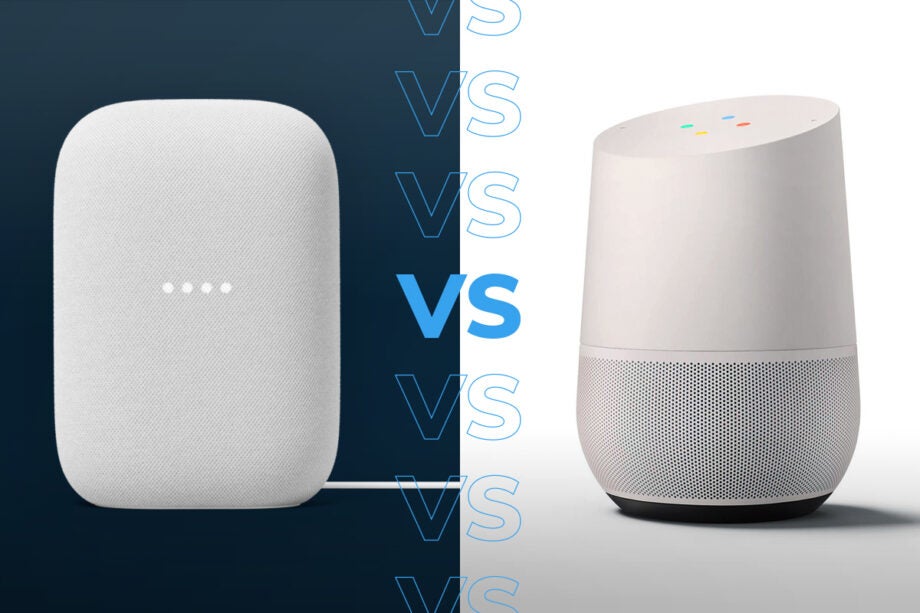Nest Audio vs Google Home: Is it worth upgrading?

Google’s finally unveiled its shiny new Nest Audio smart speaker, claiming it is a “radical” upgrade on the older Home.
But with the firm having made more bold claims during the new speaker’s 30 September unveiling than can easily be counted you may justifiably be wondering exactly how the Nest Audio compares to the original Google Home.
Here to help clear up the confusion we’ve created this guide, detailing the two smart speakers’ on paper differences.
Editor’s Note: We’ll update this page with our real-world findings when we’ve reviewed the new Nest Audio.
Related: Best smart speakers
The Nest Audio is a lot more compact
The original Google Home was a fairly chunky smart speaker with a tall, cylindrical body, mixing woven and smooth plastic parts.
As well as working to make the new Nest Audio more eco-friendly, reportedly using 70% recycled plastic on its chassis and woven grill, the firm has also shrunk it down. The speaker now sits vertically at just under 7-inches tall and is just 3.1-inches thick.
This apparently makes it easier to place than the original Home, and the Nest Audio is easier to stand against walls, or on shallow surfaces, such as a windowsill in the kitchen. Both speakers require a mains connection to work, so you’ll still need to stand them near a power socket and won’t be able to use either outside.
Privacy focussed buyers will also be pleased to hear the new Nest retains the Home’s physical mute button, which stops the speaker’s mics listening at a hardware level.
The only minor downside is that Google also hasn’t updated the Nest Audio’s wireless connectivity to support WiFi 6. Instead it caps out at 802.11ac.
The Nest Audio has a reworked control system
The Nest Audio’s design also tweaks the physical control system. The Nest Audio places volume controls on the speaker’s front-facing left and right, and play / pause functionality in the middle. The Home had its physical capacitive controls on its flat top. Of course, both speakers respond to a voice request, running the Google Assistant.
Related: Amazon Echo 4 vs Google Nest Audio
The Nest Audio should sound better
Google Home was one of the better sounding smart speakers when it first launched all the way back in 2017.
Though it doesn’t match what you’ll get from modern Echo speakers, or Google’s more recent speakers, at the time it was much more dynamic and accurate than the competition. But since Apple’s HomePod and newer Echo smart speakers started rolling out, its lead has been gradually diminishing. It should come as no surprise, then, that Google has worked hard to improve the speaker’s audio.
Under the hood, the firm has loaded the Nest Audio with a larger 75mm woofer and 19 mm tweeter. According to Google, the arrangement fixes our two biggest issues with the original Home’s audio: its tendency to distort at high volumes and its imprecise low end.
Specifically, Google claims the Nest Audio’s setup has been “finely tuned” to let it remain distortion-free and precise despite offering 75% louder max volume levels and “50% more bass performance” than the original Home. We can’t verify the claims yet, but, if accurate, the Nest Audio should be fairly impressive considering its sub-£100 price.
It’s not either or
One important thing to keep in mind is that it’s not a case of “either or” with the Home and Nest Audio. Both feature multi-room support and can be interconnected with other Google smart speakers to create multi-room, or paired with another speaker of the same type for stereo arrangements.
This is an extension of their status as “smart” speakers. The functionality means you can connect both to a growing portfolio of Google, and non-Google, smart home kit. Once setup this lets you use them to control key things, like Philips Hue smart lighting and TP Link security cameras using vocal commands, which is a pretty nifty trick.
Upgrading to the Nest Audio means that your old Google Home can be moved into another room, continuing to provide the same range of features.


